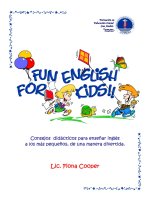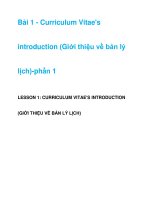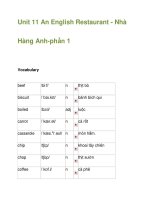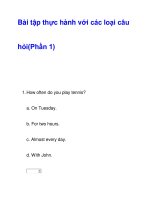fun enlish for kids phần 1 pps
Bạn đang xem bản rút gọn của tài liệu. Xem và tải ngay bản đầy đủ của tài liệu tại đây (616.52 KB, 11 trang )
How to teach English
How to teach English How to teach English
How to teach English
to
to to
to very
very very
very young children
young childrenyoung children
young children
Fiona
Fiona Fiona
Fiona L
L L
L Cooper
CooperCooper
Cooper
Fun English for Kids
Fiona L Cooper
2
Contents
ContentsContents
Contents
Introduction
3
Why teach English to young children?
4
Advice for teaching English to young children
5
Curriculum Development
7
Classroom Management
11
Curriculum for 5-year-olds
12
Units
13
My Body
13
Animals 14
School 15
The Weather 16
Transport
17
The House 18
The Family 19
Food 20
Clothes
21
Example lesson plans
22
Games
28
Songs
30
The First Lesson
36
Bibliography
38
Formación en Educación Inicial San Andrés (FEISA) is a Christian teacher training
college and is part of the Evangelical University of Paraguay
FEISA, Casilla 1124, Asunción, Paraguay
This work is licensed under the Creative Commons Attribution-Noncommercial-Share Alike 3.0 License. To view a copy of this license,
visit or send a letter to Creative Commons, 171 Second Street, Suite 300, San
Francisco, California, 94105, USA.
You are free to copy, distribute and transmit the work and to adapt it, under the following conditions:
Attribution. You must attribute the work in the manner specified by the author or licensor (but not in any way that suggests that
they endorse you or your use of the work).
Noncommercial. You may not use this work for commercial purposes.
Share Alike. If you alter, transform, or build upon this work, you may distribute the resulting work only under the same or similar
license to this one.
Fun English for Kids
Fiona L Cooper
3
Introduction
IntroductionIntroduction
Introduction
Many nurseries and pre-school classes in Paraguay offer English as part of their curriculum.
However, there is a lack of teachers who have the skill to teach it. FEISA Teacher Training
College, Asunción, aims to provide its trainee teachers with the necessary training in order to
improve the provision of English to this age group in Paraguay.
This document has been written with these trainee teachers in mind. However, other teachers
who have been asked to teach English to pre-school children may also be unsure how to start. I
hope it will prove useful to everyone who comes looking for help.
It is the fruit of three years teaching English to Spanish children (aged 3-6) in a state primary
school in Salamanca, alongside research I have since done on teaching languages to young
children. As such, it is by no means exhaustive or perfect! I do not claim to be an expert in this
field and am very open to all suggestions and constructive criticism. Please take the information
contained here and add to it, change it in any way you decide is necessary. I would ask that, in
order to help fellow teachers, you would let me know how it works for you; what you like, what
you don’t like, what changes you make.
Although this document is designed primarily for teachers of 5-year-olds, it can easily be
adapted for younger children; most of the songs and games are also suitable for children as
young as 3.
The curriculum set out in later pages is designed from a Christian perspective, because FEISA is a
Christian teacher training college and all children in Paraguayan schools are required to be
taught about God.
I acknowledge my indebtedness to Frances Smith, with whom I worked in Salamanca, and from
whom many of the ideas for games came. I would like to thank Samantha Parsons, who
encouraged me to write this guide, and Ana María Demestri, who caught the vision to take it to
schools in Paraguay. I would also like to thank Leonardo Fernández, who designed the front
cover.
To God be the glory.
Fiona Cooper
Asunción, July 2007
Fun English for Kids
Fiona L Cooper
4
Why teach English to young children?
Why teach English to young children?Why teach English to young children?
Why teach English to young children?
• The children find it easy to accept a new linguistic code because they are still learning their
own.
• They find it easy to pronounce the new sounds for the same reason.
• They don’t feel self-conscious about sounding different.
• If they have a good experience of learning a language at this age, they will remember it with
fondness, so will find it easier to learn languages later in life.
Long-term educational aims of teaching languages to young children:
• To encourage open-mindedness by preparing the child for the understanding and tolerance
of different ways of thinking and learning
• To help to improve cognitive development, by offering a further instrument for organising
knowledge
• To encourage greater creativity as a consequence of a constant comparison between two
different linguistic codes
• To lay the foundations for continuous linguistic education, allowing the formation of a type
of education that is not exclusively centred on one’s own mother tongue and that leads to
an easier study of foreign languages at higher school levels. This is particularly relevant in
Paraguay, with its bilingual education in Spanish and Guaraní.
Fun English for Kids
Fiona L Cooper
5
Advice for
Advice for Advice for
Advice for teach
teachteach
teaching
inging
ing English to young children
English to young children English to young children
English to young children
• The emphasis should be on listening and speaking the language, see below for comments on
reading and writing.
• Relate what you teach to what they already know in their own language; don’t use the new
language as the basis for teaching new concepts.
• Use as much English as possible, talk to them all the time, so that the children hear as much
as possible. This gives them more opportunity to begin to understand the language and
absorb its rhythm.
• Your first aim should be that the children understand the language they are being taught.
• Allow the children to respond in their first language, then repeat back to them in English
what they said.
• Once they understand, then you should aim for them to produce the language.
• Start with simple vocabulary: just words, not sentences.
• Go slowly, with much repetition, to give the children as much opportunity as possible to
really learn; there’s no rush.
• Gradually introduce sentences, when the children are ready, always making sure the
children understand the language.
• The lessons must be fun! The most important thing is that the children enjoy the lessons; the
children will not learn if they do not enjoy the lessons and the children’s motivation to
learn is in order to participate in the lessons.
•
Have a routine, so the children know what to expect and feel comfortable in the lessons.
•
Start each lesson with a visual signal, to show the children that it’s now the time when
another language is spoken.
•
Use body language, facial expressions and visual aids to make yourself understood; do not
resort to translation!
•
Use lots and lots of visual aids; the more visual the better, so the children have a chance to
understand even before they know the words.
•
Use games, to involve the children and make it fun.
•
Use songs, because through these, the children learn vocabulary, grammar and the rhythm of
the language without trying.
•
Use stories, because the children love them and it gives them a real experience of the
language.
•
Use short activities, to keep the children attentive.
•
Use active activities, to change the rhythm of the lesson, to keep them attentive, to stop
them fidgeting.
•
End the lesson with a quiet activity, to calm the children down for their next lesson.
•
Speak in English as much as possible (all the time, if practical!). This allows the children to
get used to the rhythm of the language and to pick up some words without really trying.
•
Use the children’s first language only when necessary, for example, to explain a game or for
discipline purposes.
Fun English for Kids
Fiona L Cooper
6
Reading and Writing
It is best if the children learn how to read and write in their own language before learning these
skills in the foreign language. This minimises the confusion of looking at the same letters and
hearing different sounds.
How to teach reading and writing in the foreign language to young children:
• First, the children need to be familiar with a wide range of vocabulary.
• Begin by reminding the children of the word, then show them the written word. Thus they
learn to associate the shape of the word with the sound, rather than relying on the
individual letter sounds to begin with.
• Once they have become familiar with a range of written words, they can be introduced to
the sounds of certain letters, as they appear in the words they already know.
• Once they have learnt the sounds of certain letters and combinations of letters (th, ch, sh,
etc), they can be introduced to more, and taught to work out how to read unfamiliar words,
using the knowledge of how each letter or combination of letters sounds.
• However, the emphasis must always be on the children learning the words orally BEFORE
they see the written words, to minimise confusion and mispronunciation.
• The fine motor skill of learning to write is best left to the first language. There is no point
in teaching how to write each letter in two languages. Therefore, the children need to learn
how to write in their own language before being asked to write in English.
Pre-requisites for a teacher of English to young children
The teacher needs to be familiar with this age group because she needs to understand something
of the needs of small children in order to teach them another language effectively. She also
needs to have a reasonable level of English herself to be able to teach it. She needs to be able
to speak with some fluency in order to give the best example to the children. If the teacher
herself lacks confidence, the children will not learn as well as they could.
Fun English for Kids
Fiona L Cooper
7
Curriculum Develop
Curriculum DevelopCurriculum Develop
Curriculum Development
mentment
ment
When designing a curriculum to teach English to young children, there are certain things we
need to consider:
These seven areas are developed over the page.
English as a
foreign language
CURRICULUM
For 5-year-olds
AIMS
What do we hope
to achieve by
teaching English
to 5-year-olds?
UNITS
What kinds of
topics do we
want to cover?
GRAMMAR
What
grammatical
structures will
we teach?
EVERYDAY
LANGUAGE
What everyday
expressions and vocab
do we want the
children to learn?
ACTIVITIES
What kinds of
activities will
we use to teach
English?
INTENDED
OUTCOMES
What do we want the
children to know/be
able to do etc?
CLASSROOM
MANAGEMENT
How are we going to
manage the children
and structure the
lessons?
Fun English for Kids
Fiona L Cooper
8
Aims
(What the teacher aims to do herself, in teaching the children English)
• To share an awareness of the wonder of God’s creation by his provision of different ways
of communication
• To teach each child as an object of God’s love and therefore to teach with an attitude of
love and acceptance
• To teach to the best of our ability, with the aim of glorifying God through our work
• To teach basic English vocab and simple grammar structures
• To provide a positive, encouraging atmosphere
• To build the children’s self-esteem
• To use activities that the children enjoy, thereby making learning fun and giving the
children motivation to learn
• To provide fun activities which give the children a desire and a need to communicate
• To give the children some awareness of a different culture
Intended Outcomes
(What the teacher wants the children to achieve as a result of the English lessons)
• That the children would develop a positive attitude towards English and languages in
general
• That the children would increase their confidence in the lessons and be willing to have a
go
• That the children would learn some simple songs in English
• That the children would understand spoken instructions, vocab and simple phrases
• That the children would be able to say simple words and phrases, including asking simple
questions and making simple requests
Fun English for Kids
Fiona L Cooper
9
Possible Units
• Animals
• Food
• School/ The Classroom
• Transport
• The House
• The World Around Us (tree, street, shop…)
• The Body
• The Weather
• The Family
• Clothes
• Holidays
• Size & Shape
Types Of Activities
• Games
• Songs
• Stories
• Art activities
• Role-play
• Routine
Everyday Language
• In games; it’s your turn, who’s won?…
• Requests for help; please help me, please tie my laces, please open this…
• Greetings; hello, how are you? What’s your name, good morning/good afternoon…
• Requests for things; please may I have ?
• Please may I go to the toilet?
• Colours
• Numbers
• Actions (bend, wiggle, wave…)
• Emotions
• Instructions
• Classroom management language
Fun English for Kids
Fiona L Cooper
10
Here is a suggested way to set out each unit
UNIT TITLE
AIMS INTENDED OUTCOMES VOCABULARY
GRAMMAR EVERYDAY EXPRESSIONS ACTIVITIES
Fun English for Kids
Fiona L Cooper
11
Classroom Management
Classroom ManagementClassroom Management
Classroom Management
• Use a wide variety of activities during a lesson in order to keep the children motivated.
• Have different activities where the children have to move around.
• Intersperse active activities with quiet ones.
• End the lesson with a quiet activity.
• Encourage the children to raise their hand when they wish to participate, not shout out.
• Sit on the floor with the children (the closer you are to their level the better so they
identify with you when you demonstrate an activity and you realise how uncomfortable it
can be!).
• Sit the children so that they all have equal access to the activity (in a circle or semi-
circle is best).
• Allow the use of L1 until the children are ready to produce L2. Whenever appropriate,
say what they have said in L1 back to them in L2.
• If you notice a particular child is becoming restless then involve him directly in the lesson
immediately, e.g. give him the next turn at the game or give him a job to do (collect the
cards from the others or stick the pictures on the wall etc)
• Give lots of encouragement and praise.
• Try to avoid misbehaviour by using the above strategies, but when it happens, as is
inevitable,
1. Make sure the misbehaviour is not the result of misunderstanding your instructions.
2. Use L1 if necessary so the child understands what is happening.
3. If possible, discipline the child on his own, not in front of the whole group (not always
possible!)
4. Use punishments appropriate to the age of the child and consistent with the whole
school policy (if there is such a thing!)
5. Have strategies already thought-out, for example a rising scale of punishment if the
child continues to misbehave, which can be communicated to the whole class and
therefore all the children know what to expect if they misbehave. For example:
I. Warning; if you do that again, you’ll have to sit apart from the group
II. Sit the child apart from the group for a short and specified period of time
(e.g.1 minute for each year of their life)
III. Send the child to another teacher to be disciplined verbally
IV. The child loses a few minutes of break time
BE CONSISTENT; use the same strategies with all children and every time there is
misbehaviour and if you threaten a punishment make sure you carry it out.









